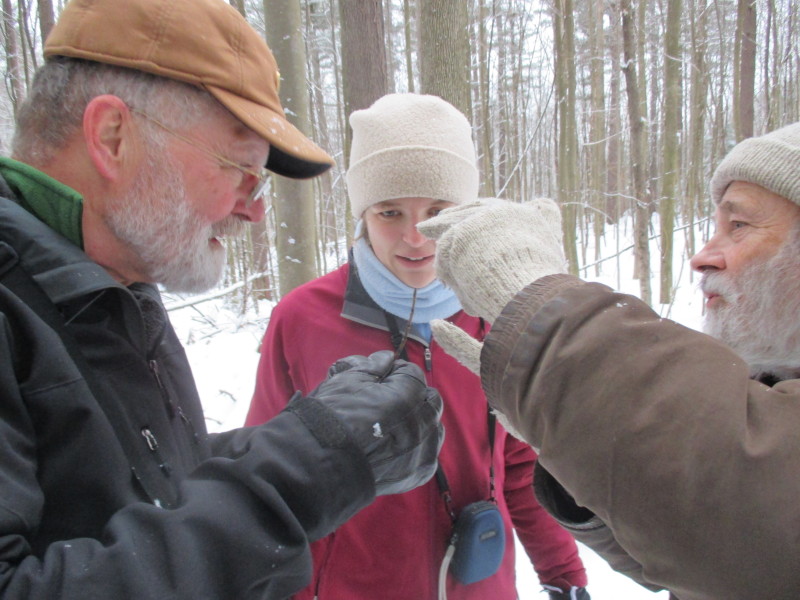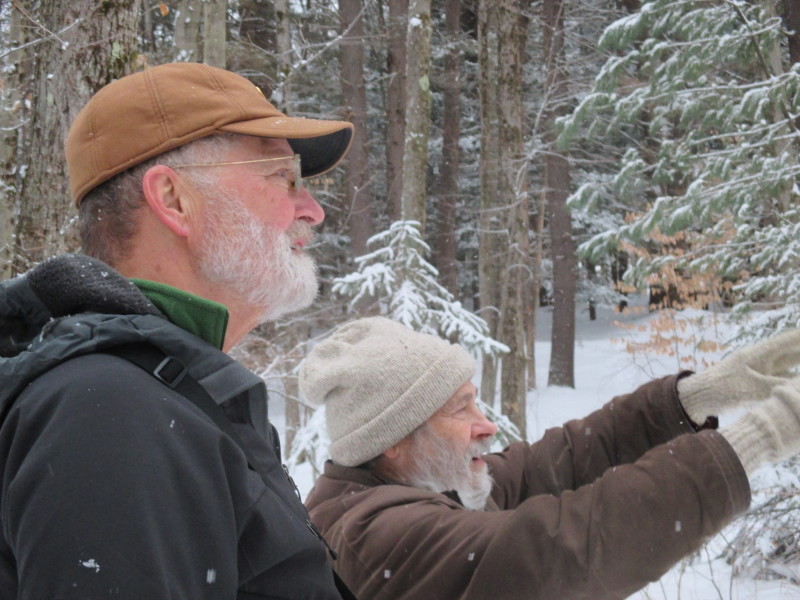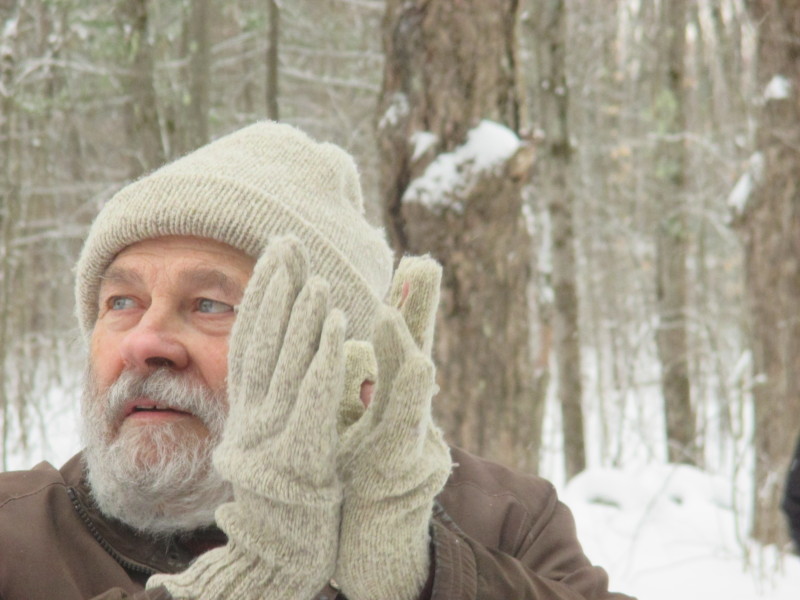THE GLOBAL IS LOCAL: THE CLIMATE IS CHANGING AND WITH IT, OUR SEASONS
Scientists will tell you the climate is changing. So will John Latimer.
A postman in Grand Rapids, Latimer recorded the changing seasons in nature as he drove his 100-mile route for 30 years in rural Minnesota. Latimer said he started keeping records of what he saw and heard around him on his route as the seasons unfolded just to keep life interesting. When did the lady slippers bloom, the trees bud out, the frogs start calling? He wrote it all down. Latimer said his patrons soon learned if they saw his car off by the side of the road, their mail might be a tad late: “My patrons were very forgiving, my car would be off in a ditch, I’d be off looking at some plant.”

John Latimer, left, with Miriam Johnston of the Richardson Lab and John O’Keefe, Harvard Forest field phenologist, enjoying a winter walk at the Harvard Forest on a recent visit. They are collaborating on research that uses observations of seasonal rhythms of nature to document climate change.
Latimer became so bitten by the phenology bug, he even started a radio program on radio station KAXE in Grand Rapids about phenology – the formal name for looking and listening for seasonal changes in nature, and keeping a record of observations over time. Latimer’s phenology program is the most popular show in his market. The station also hosts Latimer’s list of events to watch for in nature every month on its home page. Whether it’s pussy willow catkins emerging and bald eagles returning to nests in March, or the songs of wood frogs, dandelions putting up first flowers and painted turtles emerging from hibernation in April, Latimer invites people to tune into the wonder of life all around us, and take note of the grand pageant of nature’s seasonal rhythms. He’s posting right now about the first sights and sounds of spring to more than 300 followers on Twitter, and has a Season Watch Facebook Group page, where people put up their own photos and observations.
That’s new technology for a very old practice. Some of the earliest phenological records are thought to be those of crop yields in ancient China in about 974 BC. In Japan, written records of annual peak flowering times of cherry blossoms have been maintained for more than 1200 years.
Now climate change has brought a resurgence of interest in phenology. The seasons aren’t what they used to be. People see and sense what nature is telling us: while every year is different, on average, over the past two decades spring is coming earlier, fall later, and winter is getting squeezed on both ends. And that has consequences for living things of just about every sort, and their environment.

Latimer, left, and O’Keefe share an infectious enthusiasm for understanding the workings of the natural world.
The link between observable changes in seasonal rhythms of nature and climate change is also giving phenology new relevance for climate change researchers. Andrew Richardson, associate professor at Harvard University, has been using a 25-year record of tree phenology compiled at the Harvard Forest by field phenologist John O’Keefe in his climate change work.
O’Keefe’s observations of the same 40 tracked trees in spring and 50 in fall comprise the best phenological record known anywhere of woody species, for the quality and consistency of his observations, the number of species he watches, and availability of his work for researchers. His data is frequently used by researchers investigating the effects of climate change on forest ecosystems.
Phenology research at the Harvard Forest shows those connections, in ground-level, observable effects from earlier spring bud break to later frost, keeping the leaves on the trees deep into fall. “It’s a way of knowing what the plants are doing,” O’Keefe said. “We need those plant-level observations to know what is actually happening.”

O’Keefe, right, will begin his 26th year of phenology observations in the Harvard Forest this spring, in collaboration with the Richardson Lab at Harvard University.
Now the Richardson Lab is bringing a similar approach to a new venue, using Latimer’s data. Graduate student Miriam Johnston in the Richardson Lab has taken on the project of incorporating Latimer’s data in the lab’s new project, improving models predicting phenological responses to global climate change at the USDA Marcell Experimental Forest in Northern Minnesota. In addition to their work at the Harvard Forest, the lab is developing forecasts of how peatland phenology will respond to climate change over the next 50 to 100 years.
Foot for foot, peatlands pack away more carbon than any other land ecosystem – more than tropical rainforests, more than grasslands, more than woodlands of the Northeast or old growth forests of the Pacific Northwest. Three percent of the Earth’s land surface is in peat bogs, Johnston noted, and they hold the equivalent of about half the amount of carbon in the atmosphere as C02 today. If peatlands degrade, they could release their carbon, worsening our climate change woes. “So it is good to know what is happening there,” Johnston said.

Miriam Johnston of the Richardson Lab is working with Latimer to incorporate his data into the lab’s work improving computer models of climate change.
Latimer and O’Keefe have each seen big changes in the environments they observe over the years. It was not uncommon to have a hard frost anytime from mid-September, even early September, O’Keefe said. “Now it can be mid and even late October.” Latimer, meanwhile, said he has watched the growing season extend by about a month in Minnesota. He’s found out the hard way that ponds he used to confidently skate don’t freeze like they used to.
No wonder. Globally, last year was the hottest since record keeping began in the 1880s, the Intergovernmental Panel on Climate Change reports, with the increase in global average temperature closely tracking rising levels of atmospheric C02. Greenhouse gas concentrations in the atmosphere are the highest they have been in at least 800,000 years, rocketing to more than 400 ppm C02 and climbing in just the past 150 years. This change in the air has direct effects on physical and ecological systems on the ground – because of course they are connected.
Phenology is helpful to science, but it is also just a wonderful way to connect to the natural world. “You become intimately conscious of what is out there,” Latimer said of his phenology walks. “What am I going to see today, what wonderful thing will happen?” Latimer recently retired from his mail route, but he’s keeping up his radio show and still checks up on parts of his route. The lady slippers, for instance, draw him back. “They were my pets for 20 years I was waiting for when they would come up out of the ground.

In addition to being useful to science, phenology is also a wonderful way to connect with the natural world. O’Keefe explains the workings of hobblebush, a native species without covering on its buds.
“When you go out to check on some plants it’s like checking on your kids,” Latimer said. O’Keefe says of his trees: “For the most part they are all good friends.”
Beyond phenology, the two also share a path of serendipity. Neither started off in the sciences, but found their way to phenology as their career paths unfolded. A sociology major at Harvard, O’Keefe said he was always interested in science. After a stint in the Peace Corps and the Massachusetts Air National Guard, he decided he wanted to learn what was going on in all that forest he was flying over, piloting an F-106. He went on to earn a PhD in forest biology, and work at the Harvard Forest, as director of the Fisher Museum. O’Keefe initiated his phenology walks while working at the forest, and has continued them in his emeritus position in retirement. He’ll begin his 26th year of walks in collaboration with the Richardson Lab this spring.
For his part, Latimer says he never expected to be a postman. But when he bailed on his training as an economist, he never looked back. “One day I just looked out the window and thought, ‘God I wish I was outside.’”

Neither O’Keefe,right, or Latimer, started out in the sciences but the joy of discovery drew them in to their study of the natural world through phenology.


Leave a Reply